2006 Hyundai Terracan weight
[x] Cancel search: weightPage 442 of 539
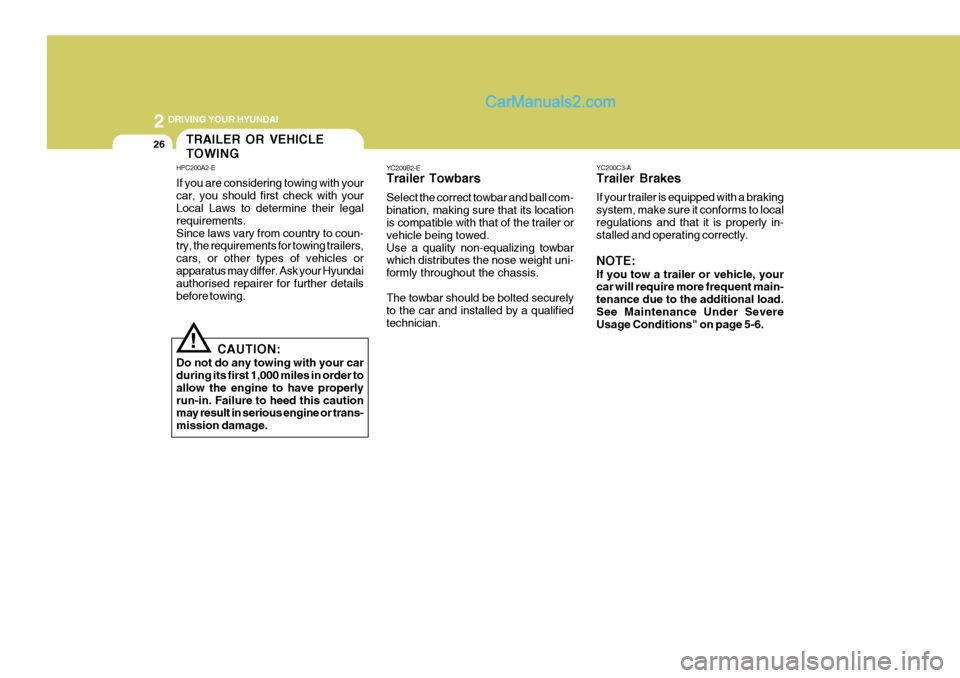
2 DRIVING YOUR HYUNDAI
26
YC200C3-A Trailer Brakes If your trailer is equipped with a braking system, make sure it conforms to localregulations and that it is properly in- stalled and operating correctly. NOTE: If you tow a trailer or vehicle, your car will require more frequent main- tenance due to the additional load.See Maintenance Under Severe Usage Conditions" on page 5-6.
YC200B2-E Trailer Towbars Select the correct towbar and ball com- bination, making sure that its location is compatible with that of the trailer or vehicle being towed.Use a quality non-equalizing towbar which distributes the nose weight uni- formly throughout the chassis. The towbar should be bolted securely to the car and installed by a qualifiedtechnician.
!
CAUTION:
Do not do any towing with your car during its first 1,000 miles in order to allow the engine to have properlyrun-in. Failure to heed this caution may result in serious engine or trans- mission damage.
TRAILER OR VEHICLE TOWING
HPC200A2-E If you are considering towing with your car, you should first check with your Local Laws to determine their legal requirements.Since laws vary from country to coun- try, the requirements for towing trailers, cars, or other types of vehicles orapparatus may differ. Ask your Hyundai authorised repairer for further details before towing.
Page 443 of 539
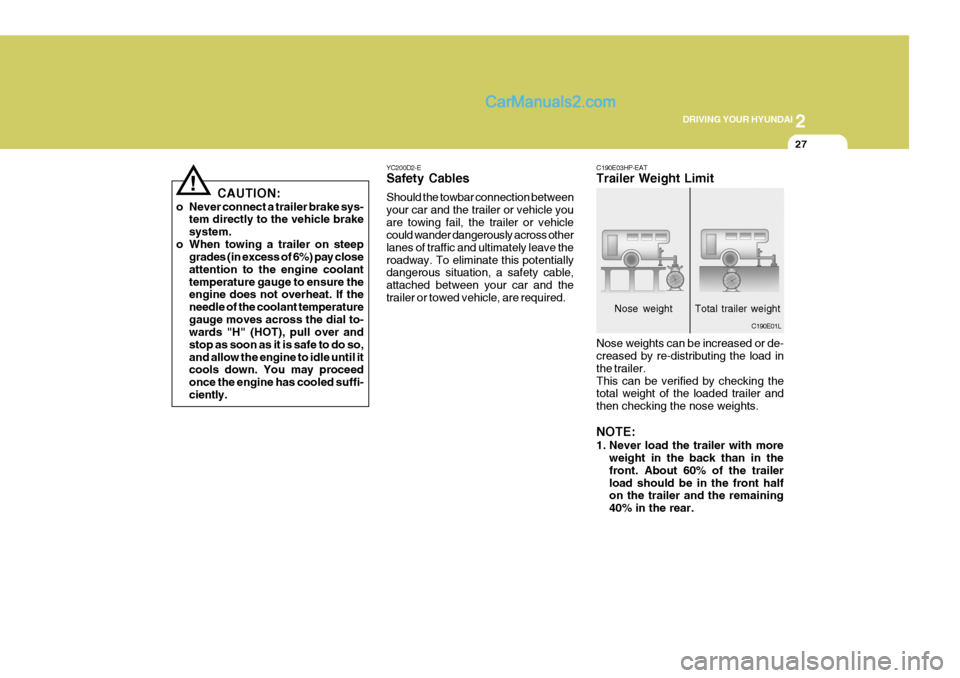
2
DRIVING YOUR HYUNDAI
27
!
CAUTION:
o Never connect a trailer brake sys- tem directly to the vehicle brake system.
o When towing a trailer on steep grades (in excess of 6%) pay closeattention to the engine coolanttemperature gauge to ensure the engine does not overheat. If the needle of the coolant temperaturegauge moves across the dial to- wards "H" (HOT), pull over and stop as soon as it is safe to do so,and allow the engine to idle until it cools down. You may proceed once the engine has cooled suffi-ciently. YC200D2-E Safety Cables Should the towbar connection between your car and the trailer or vehicle youare towing fail, the trailer or vehicle could wander dangerously across other lanes of traffic and ultimately leave theroadway. To eliminate this potentially dangerous situation, a safety cable, attached between your car and thetrailer or towed vehicle, are required.
C190E03HP-EAT Trailer Weight Limit Nose weights can be increased or de- creased by re-distributing the load in the trailer.This can be verified by checking the total weight of the loaded trailer and then checking the nose weights. NOTE:
1. Never load the trailer with more
weight in the back than in the front. About 60% of the trailerload should be in the front half on the trailer and the remaining 40% in the rear.
C190E01L
Nose weight Total trailer weight
Page 444 of 539

2 DRIVING YOUR HYUNDAI
28
!
CAUTION:
The following specifications are recommended when towing a trailer. The loaded trailer weight can- not safely exceed the values in thechart.
3. The front or rear axle weight must
not exceed the Gross Axle WeightRating (GAWR) shown on the ve- hicle identification plate (see page 8-2). It is possible that your towingpackage does not exceed the GVWR but exceeds the GAWR. Improper trailer loading and/or toomuch luggage in the luggage com- partment can overload the rear axle. Redistribute the load andcheck the axle weight again.
4. The maximum permissible static
vertical load (nose weight) on thecoupling device is 247 Lbs. (112kg)
5. The maximum permissible over-
hang of the coupling point is 44.7inches (1135 mm).
Gross axle weight
C190E02LGross vehicleweight
C190E01HP
Coupling point
Spare tyre
2. The total gross vehicle weight with trailer must not exceed the Gross Vehicle Weight Rating (GVWR) shown on the vehicle identifica-tion plate (see page 8-2). The total gross vehicle weight is the com- bined weight of the vehicle, driver,all passengers and their luggage, cargo, towbar hitch, trailer nose weight and other optional equip-ment.
Page 445 of 539
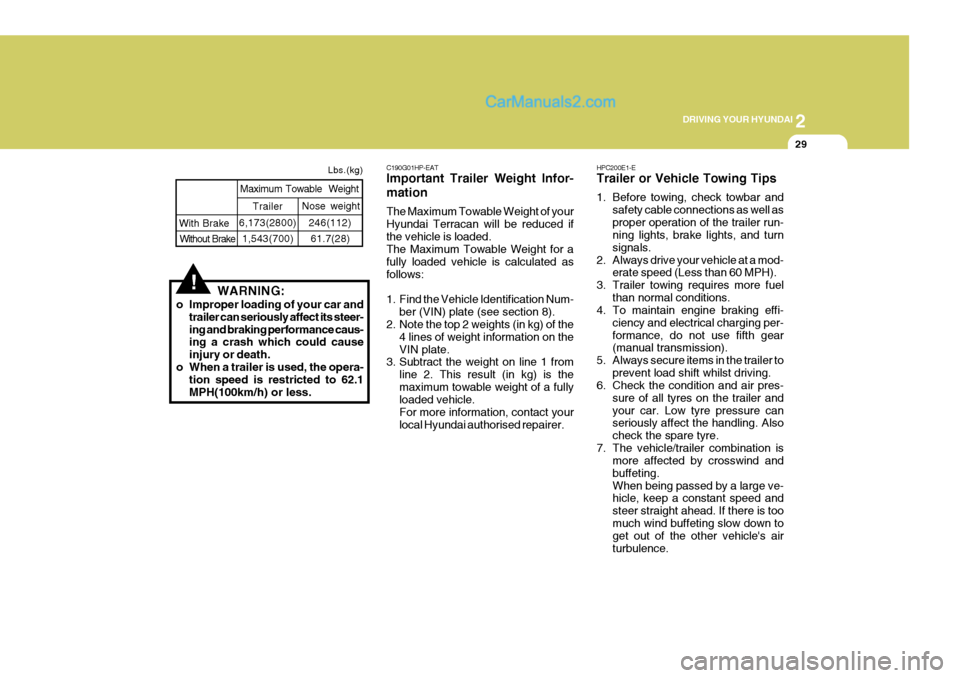
2
DRIVING YOUR HYUNDAI
29
!
Trailer
With Brake
Maximum Towable Weight
Nose weight
Lbs.(kg)
WARNING:
o Improper loading of your car and trailer can seriously affect its steer- ing and braking performance caus- ing a crash which could cause injury or death.
o When a trailer is used, the opera-
tion speed is restricted to 62.1MPH(100km/h) or less.
Without Brake
6,173(2800)
1,543(700) 246(112)
61.7(28) C190G01HP-EAT Important Trailer Weight Infor- mation The Maximum Towable Weight of your Hyundai Terracan will be reduced ifthe vehicle is loaded. The Maximum Towable Weight for a fully loaded vehicle is calculated asfollows:
1. Find the Vehicle Identification Num-
ber (VIN) plate (see section 8).
2. Note the top 2 weights (in kg) of the
4 lines of weight information on the VIN plate.
3. Subtract the weight on line 1 from
line 2. This result (in kg) is themaximum towable weight of a fully loaded vehicle. For more information, contact yourlocal Hyundai authorised repairer. HPC200E1-E Trailer or Vehicle Towing Tips
1. Before towing, check towbar and
safety cable connections as well as proper operation of the trailer run- ning lights, brake lights, and turn signals.
2. Always drive your vehicle at a mod- erate speed (Less than 60 MPH).
3. Trailer towing requires more fuel than normal conditions.
4. To maintain engine braking effi-
ciency and electrical charging per-formance, do not use fifth gear (manual transmission).
5. Always secure items in the trailer to prevent load shift whilst driving.
6. Check the condition and air pres-
sure of all tyres on the trailer and your car. Low tyre pressure can seriously affect the handling. Also check the spare tyre.
7. The vehicle/trailer combination is more affected by crosswind andbuffeting.When being passed by a large ve- hicle, keep a constant speed and steer straight ahead. If there is toomuch wind buffeting slow down to get out of the other vehicle's air turbulence.
Page 511 of 539
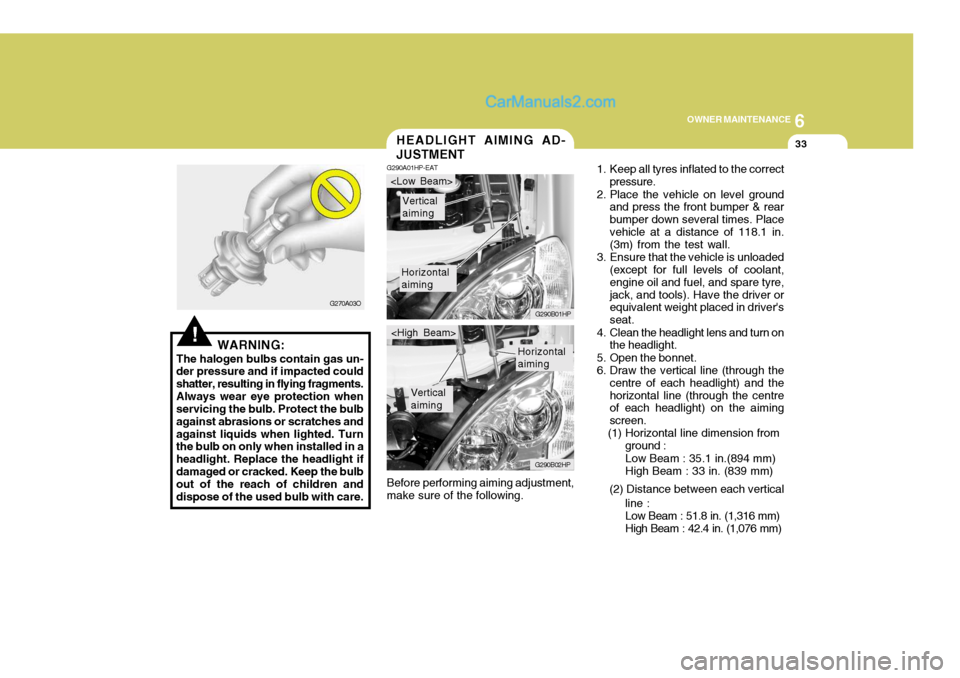
6
OWNER MAINTENANCE
33
Before performing aiming adjustment, make sure of the following.HEADLIGHT AIMING AD- JUSTMENT
G290A01HP-EAT
1. Keep all tyres inflated to the correct
pressure.
2. Place the vehicle on level ground and press the front bumper & rear bumper down several times. Placevehicle at a distance of 118.1 in. (3m) from the test wall.
3. Ensure that the vehicle is unloaded (except for full levels of coolant, engine oil and fuel, and spare tyre,jack, and tools). Have the driver or equivalent weight placed in driver's seat.
4. Clean the headlight lens and turn on the headlight.
5. Open the bonnet.
6. Draw the vertical line (through the centre of each headlight) and thehorizontal line (through the centre of each headlight) on the aiming screen.
(1) Horizontal line dimension from
Horizontal aiming
Vertical aiming
G290B01HP
G290B02HP
Horizontal aiming
Vertical aiming
ground :Low Beam : 35.1 in.(894 mm) High Beam : 33 in. (839 mm)
(2) Distance between each vertical line :Low Beam : 51.8 in. (1,316 mm) High Beam : 42.4 in. (1,076 mm)
!WARNING:
The halogen bulbs contain gas un-
der pressure and if impacted could shatter, resulting in flying fragments.Always wear eye protection when servicing the bulb. Protect the bulb against abrasions or scratches andagainst liquids when lighted. Turn the bulb on only when installed in a headlight. Replace the headlight ifdamaged or cracked. Keep the bulb out of the reach of children and dispose of the used bulb with care. G270A03O
Page 538 of 539
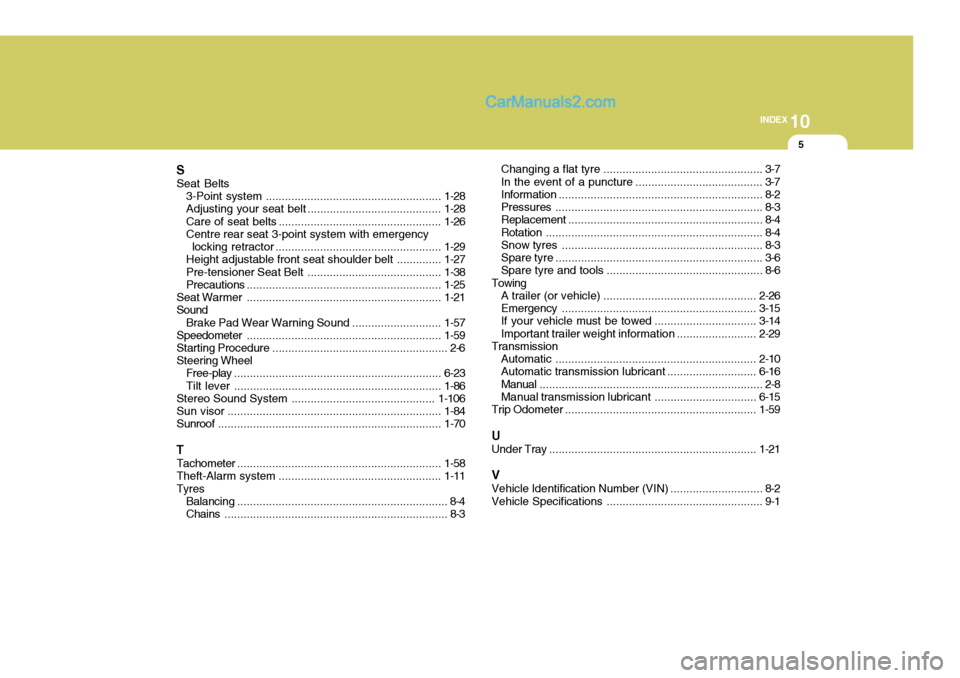
10
INDEX
5
S Seat Belts 3-Point system ....................................................... 1-28
Adjusting your seat belt .......................................... 1-28
Care of seat belts ................................................... 1-26
Centre rear seat 3-point system with emergency
locking retractor .................................................... 1-29
Height adjustable front seat shoulder belt ..............1-27
Pre-tensioner Seat Belt .................. ........................1-38
Precautions ............................................................. 1-25
Seat Warmer ............................................................. 1-21
Sound
Brake Pad Wear Warning Sound ............................ 1-57
Speedometer ............................................................. 1-59
Starting Procedure ....................................................... 2-6
Steering Wheel Free-play ................................................................. 6-23
Tilt lever ................................................................. 1-86
Stereo Sound System ............................................. 1-106
Sun visor ................................................................... 1-84
Sunroof ...................................................................... 1-70
T Tachometer ................................................................ 1-58
Theft-Alarm system ................................................... 1-11
Tyres Balancing .................................................................. 8-4
Chains ...................................................................... 8-3 Changing a flat
tyre .................................................. 3-7
In the event of a puncture ........................................ 3-7 Information ................................................................ 8-2
Pressures ................................................................. 8-3
Replacement ............................................................. 8-4
Rotation .................................................................... 8-4
Snow tyres ............................................................... 8-3
Spare tyre ................................................................. 3-6Spare tyre and tools ................................................. 8-6
Towing A trailer (or vehicle) ................................................ 2-26
Emergency ............................................................. 3-15
If your vehicle must be towed ................................ 3-14
Important trailer weight information ......................... 2-29
Transmission
Automa tic ............................................................... 2-10
Automatic transmission lubricant ............................ 6-16
Manual ...................................................................... 2-8
Manual transmission lubricant ................................ 6-15
Trip Odometer ............................................................ 1-59
U Under Tray ................................................................. 1-21
VVehicle Identification Number (VIN) ............................. 8-2
Vehicle Specifica tions ................................................. 9-1